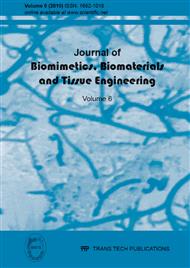p.1
p.19
p.35
p.45
p.57
p.67
p.87
Porous PLGA Microspheres Effectively Loaded with BSA Protein by Electrospraying Combined with Phase Separation in Liquid Nitrogen
Abstract:
Polymer microspheres loaded with bioactive particles, biomolecules, proteins, and/or growth factors play important roles in tissue engineering, drug delivery, and cell therapy. The conventional double emulsion method and a new method of electrospraying into liquid nitrogen were used to prepare bovine serum albumin (BAS)-loaded poly(lactic-co-glycolic acid) (PLGA) porous microspheres. The particle size, the surface morphology and the internal porous structure of the microspheres were observed using scanning electron microscopy (SEM). The loading efficiency, the encapsulation efficiency, and the release profile of the BSA-loaded PLGA microspheres were measured and studied. It was shown that the microspheres from double emulsion had smaller particle sizes (3-50 m), a less porous structure, a poor loading efficiency (5.2 %), and a poor encapsulation efficiency (43.5%). However, the microspheres from the electrospraying into liquid nitrogen had larger particle sizes (400-600 m), a highly porous structure, a high loading efficiency (12.2%), and a high encapsulation efficiency (93.8%). Thus the combination of electrospraying with freezing in liquid nitrogen and subsequent freeze drying represented a suitable way to produce polymer microspheres for effective loading and sustained release of proteins.
Info:
Periodical:
Pages:
1-18
Citation:
Online since:
September 2010
Authors:
Price:
Сopyright:
© 2010 Trans Tech Publications Ltd. All Rights Reserved
Share:
Citation:


